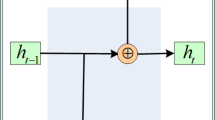Abstract
Temporal convolutional autoencoder has an important value of application in time-series analysis. In the paper we aim to use temporal convolutional autoencoder to help find out abnormal stocks quickly in the scenario of financial trading market. However, there are still two critical problems to solve during the application of temporal convolutional autoencoder. First, trading data of each stock are multidimensional time-series data, while classical temporal convolutional autoencoder only applies to one-dimension data. Second, stock trading data in a market are huge and their analysis consumes a long time, which contradicts the demand of quick decision in stock trading. To solve the above problems, we improve temporal convolutional autoencoder based on multidimensional sampling, convolution kernel generated by prior knowledge, temporal feature reuse, parallel training on clouds. All the techniques help temporal convolutional autoencoder find abnormal stocks quickly and well. Extended experiments demonstrate that our proposed temporal convolutional autoencoder could raise F1 score to more than seventy percent. The largest time efficiency of finding abnormal stocks can be increased by ninety percent as well.








Similar content being viewed by others
REFERENCES
Aggarwal, R.K. and Wu, G., Stock market manipulation—Theory and evidence, AFA 2004 San Diego Meetings, 2003. https://doi.org/10.2139/ssrn.474582
Gianniotis, S.D., Kügler, P., Tiňo, and Polsterer, K.L., Model-coupled autoencoder for time series visualisation, Neurocomputing, 2016, vol. 192, pp. 139–146. https://doi.org/10.1016/j.neucom.2016.01.086
Xu, H., Chen, W., Zhao, N., Li, Z., Bu, J., Li, Z., Liu, Y., Zhao, Y., Pei, D., Feng, Y., Chen, J., Wang, Z., and Qiao, H., Unsupervised anomaly detection via variational auto-encoder for seasonal KPIs in web applications, Proc. 2018 World Wide Web Conf., Lyon, 2018, Int. World Wide Web Conf. Steering Committee, 2018, pp. 187–196. https://doi.org/10.1145/3178876.3185996
Xidonas, P., Mavrotas, G., Krintas, T., Psarras, J., and Zopounidis, C., Stock selection, Multicriteria Portfolio Management, Springer Optimization and Its Applications, vol. 69, New York: Springer, 2012, pp. 23–55. https://doi.org/10.1007/978-1-4614-3670-6_3
Goldfarb, D. and Iyengar, G., Robust portfolio selection problems, Math. Oper. Res., 2003, vol. 28, no. 1, pp. 1–38. https://doi.org/10.1287/moor.28.1.1.14260
Barber, B.M. and Lyon, J.D., Detecting long-run abnormal stock returns: The empirical power and specification of test statistics, J. Financial Econ., 1997, vol. 43, no. 3, pp. 341–372. https://doi.org/10.1016/S0304-405X(96)00890-2
Abdelouahab, K., Pelcat, M., Serot, J., and Berry, F., Accelerating CNN inference on FPGAs: A survey, 2018. arXiv:1806.01683 [cs.DC]
Ye, J., Hu, Y., and Li, X., Hardware trojan in FPGA CNN accelerator, IEEE 27th Asian Test Symp. (ATS), Hefei, China, 2018, IEEE, 2018, pp. 68–73. https://doi.org/10.1109/ATS.2018.00024
Chen, T., Du, Z., Sun, N., Wang, J., Wu, C., Chen, Y., and Temam, O., DianNao: A small-footprint high-throughput accelerator for ubiquitous machine-learning, ACM SIGARCH Comput. Archit. News, 2014, vol. 42, no. 1, pp. 269–284. https://doi.org/10.1145/2654822.2541967
Merolla, P., Arthur, J., Akopyan, F., Imam, N., Manohar, R., and Modha, D.S., A digital neurosynaptic core using embedded crossbar memory with 45 pJ per spike in 45 nm, IEEE Custom Integrated Circuits Conf. (CICC), San Jose, Calif., 2011, IEEE, 2011, pp. 1–4. https://doi.org/10.1109/CICC.2011.6055294
Deepak, K., Chandrakala, S., and Mohan, C.K., Residual spatiotemporal autoencoder for unsupervised video anomaly detection, Signal Image Video Process., 2021, vol. 15, pp. 215–222. https://doi.org/10.1007/s11760-020-01740-1
Li, N. and Chang, F., Video anomaly detection and localization via multivariate Gaussian fully convolution adversarial autoencoder, Neurocomputing, 2019, vol. 369, pp. 92–105. https://doi.org/10.1016/j.neucom.2019.08.044
Thill, M., Konen, W., Wang, H., and Bäck, T., Temporal convolutional autoencoder for unsupervised anomaly detection in time series, Appl. Soft Comput., 2021, vol. 112, p. 107751. https://doi.org/10.1016/j.asoc.2021.107751
Utkin, L.V., Zaborovskii, V.S., and Popov, S.G., Detection of anomalous behavior in a robot system based on deep learning elements, Autom. Control Comput. Sci., 2016, vol. 50, no. 8, pp. 726–733. https://doi.org/10.3103/S0146411616080319
Gao, Z., Shen, C., and Xie, C., Stacked convolutional auto-encoders for single space target image blind deconvolution, Neurocomputing, 2018, vol. 313, pp. 295–305. https://doi.org/10.1016/j.neucom.2018.06.009
Turchenko, V. and Luczak, A., Creation of a deep convolutional auto-encoder in Caffe, 9th IEEE Int. Conf. on Intelligent Data Acquisition and Advanced Computing Systems: Technology and Applications (IDAACS), Bucharest, 2017, IEEE, 2017, pp. 675–678. https://doi.org/10.1109/IDAACS.2017.8095172
Waldrop, M.M., What are the limits of deep learning?, Proc. Natl. Acad. Sci. U. S. A., 2019, vol. 116, no. 4, pp. 1074–1077. https://doi.org/10.1073/pnas.1821594116
Funding
This work was supported by Science and Technology Plan for Colleges and Universities in Shandong Province (KJ2018BAN046) and the National Natural Science Foundation of China (grant no. 61703234).
Author information
Authors and Affiliations
Corresponding author
Ethics declarations
The authors declare that they have no conflicts of interest.
About this article
Cite this article
Lida Zou Rapid Discovery Approach of Abnormal Stocks Based on Temporal Convolutional Autoencoder. Aut. Control Comp. Sci. 56, 209–220 (2022). https://doi.org/10.3103/S0146411622030117
Received:
Revised:
Accepted:
Published:
Issue Date:
DOI: https://doi.org/10.3103/S0146411622030117




